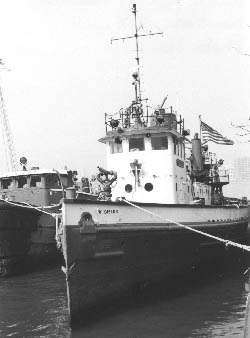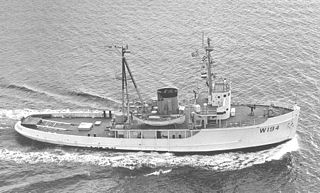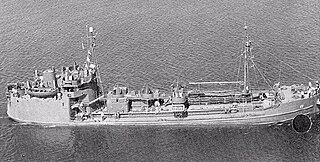Related Research Articles

USS Alameda, was a United States Navy tanker in commission from 1919 to 1922. She was built as the civilian tanker SS Alameda, but transferred to the U.S. Navy after completion in 1919. She was sold for commercial service and operated under the names SS Olean and SS Sweep before she was transferred to the Navy again in World War II as USS Silver Cloud (IX-143).

The T2 tanker, or T2, was a class of oil tanker constructed and produced in large numbers in the United States during World War II. Only the T3 tankers were larger "navy oilers" of the period. Some 533 T2s were built between 1940 and the end of 1945. They were used to transport fuel oil, diesel fuel, gasoline and sometimes black oil-crude oil. Post war many T2s remained in use; like other hastily built World War II ships pressed into peacetime service, there were safety concerns. As was found during the war, the United States Coast Guard Marine Board of Investigation in 1952 stated that in cold weather the ships were prone to metal fatigue cracking, so were "belted" with steel straps. This occurred after two T2s, Pendleton and Fort Mercer, split in two off Cape Cod within hours of each other. Pendleton's sinking is memorialized in the 2016 film The Finest Hours. Engineering inquiries into the problem suggested the cause was poor welding techniques. It was found the steel was not well suited for the new wartime welding construction. The high sulfur content made the steel brittle and prone to metal fatigue at lower temperatures.

John J. Harvey is a fireboat formerly of the New York City Fire Department (FDNY) in New York City, famed for returning to service following the September 11, 2001 attacks. She is one of the most powerful fireboats ever built, capable of pumping up to 18,000 gallons of water a minute.

USCGC Madrona (WLB-302) was a U.S. Coast Guard 180 foot seagoing buoy tender. Madrona was built by the Zenith Dredge Company of Duluth, Minnesota at a cost of $949,144.

USS Unimak (AVP-31) was a United States Navy Barnegat-class small seaplane tender in commission from 1943 to 1946 that saw service in World War II. After the war, she was in commission in the United States Coast Guard as the cutter USCGC Unimak (WAVP-379), later WHEC-379, WTR-379, and again WHEC-379, from 1949 to 1975 and from 1977 to 1988.

The SS City of Everett was an important whaleback steamship. She sailed from 1894 until 1923, and was the first U.S. steamship to pass through the Suez Canal, as well as the first to circumnavigate the globe. Her radio call letters were GF and her signal letters KMCQ.

USCGC Escanaba (WHEC-64) was an Owasco-class high endurance cutter built for World War II service with the United States Coast Guard. The war ended before the ship was completed and consequently she never saw wartime service.
Esso Brussels was a commercial oil tanker built for the Esso Oil company in 1959. She was involved in a collision in 1973 in which thirteen of her crew perished. She was rebuilt and sailed under various other names until being scrapped in 1985.

For other ships of the same name, see ARC San Andres

The auxiliary ocean tug USS ATA-194 was laid down on 7 November 1944 at Orange, Texas, by the Levingston Ship Building Co.; launched 4 December 1944; and commissioned at Orange on 14 February 1945.
Sea Witch was a MARAD Type C5-S-73b container ship built at the Bath Iron Works shipyard for American Export-Isbrandtsen Lines. She operated in the Atlantic trades for five years. So engaged on the evening of June 1, 1973, the vessel was involved in a disastrous collision with the oil tanker Esso Brussels in lower New York Harbor and was damaged so badly that she was removed from active service.
The Venpet–Venoil collision was a maritime accident involving sister supertankers; the Liberian-registered Venoil and Venpet, in dense fog off the coast of South Africa on 16 December 1977. The tankers were travelling in opposite directions; the Venoil fully laden with over 250,000 tonnes of crude oil bound for Halifax, Canada, and the Venpet, travelling in ballast, headed for Kharg Island, Iran. The Venoil ploughed into the Venpet, eventually leading to the spilling of approximately 26,600–30,500 tonnes of crude oil. The tankers were sister ships owned and operated by Bethlehem Steel Corporation. Both ships were manned by Taiwanese crews.
MV C.O. Stillman was an oil tanker that was built by a German shipyard in 1928 for a Canadian-based shipping company. A Panamanian subsidiary of Esso bought her at the end of 1936 and she was sunk by the German submarine U-68 in the Caribbean on June 4, 1942 about 41 nautical miles (76 km) southwest of Isla de Mona, Puerto Rico.

The T1 tanker or T1 are a class of sea worthy small tanker ships used to transport fuel oil before and during World War II, Korean War and Vietnam War. The T1 tanker classification is still in use today. T1 tankers are about 200 to 250 feet in length and are able to sustain a top speed of about 12 knots. The hull designation AO is used by the US Navy to denote the ship is a T1 oil tanker and AOG that the T1 is a gasoline tanker. The small size allows the T1 to enter just about any sea port or to anchor around a small island, this was very useful during the Pacific War. The T1 tanker can carry about 48,000 to 280,000 bbls. Some T1 tankers were used to transport goods other than oil, a few were used for black oil-crude oil, diesel, chemicals and rarely bulk cargo like grain. T1 tankers are also called liquid cargo carriers. The T1 tanker has about a 6,000 to 35,000 deadweight tonnage (DWT) of cargo. The small size also gives the ships short turn around time for repair, cleaning, loading and unloading. A T1 tanker carrying dirty cargo, like crude oil needs a few weeks of labor to clean before carrying clean cargo. Most T1 ships during World War II were named after major oil fields.

Brown Victory was a Maritime Commission type VC2-S-AP2 Victory ship built during World War II under the Emergency Shipbuilding program. The ship was built by Oregon Shipbuilding Company Portland as Maritime Commission hull 171, yard number 1225. Her keel was laid on 25 February 1945. She was named for Brown University and christened on 2 May 1945. The ship was completed and delivered to the War Shipping Administration (WSA) with operation under WSA agreement by the Alaska Packers' Association on 27 March 1945. That agreement remained in effect until 2 July 1946.
MV S.E. Graham was an oil tanker that was built in 1943 and operated by the Graham Company until her loss in 1958. She was 250 feet (76 m) in length and measured 1,591 gross tons.
The 1958 East River collision occurred on the morning of June 25, 1958, two ships collided in the East River in New York City, resulting in a fire, a gasoline spill, and the deaths of two crewmembers.
SSGrand Zenith was an oil tanker that sank sometime after December 30, 1976 with the loss of all hands.
In fire and explosion prevention engineering, inerting refers to the introduction of an inert (non-combustible) gas into a closed system to make a flammable atmosphere oxygen deficient and non-ignitable.

Governor Alfred E. Smith was a fireboat first operated by the Fire Department of New York in 1961. She was the last of four sister ships. In 1970 the Department planned to retire her, but, instead, she was placed in reserve. She was finally retired on October 21, 2016. Governor Alfred E Smith was built by John H. Mathis & Company at Camden, New Jersey, yard number 216 in August 1961.
References
- 1 2 3 "MV Alva Cape (+1966)". Wrecksite. Retrieved April 4, 2017.
- 1 2 "Alva Cape (5013088)" . Miramar Ship Index . Retrieved September 21, 2018.
- 1 2 3 4 5 6 7 8 9 10 11 12 "21 Killed and 40 Hurt in Fiery Collision Of 2 Tankers Near the Bayonne Bridge" (PDF). The New York Times. June 17, 1966. Retrieved April 4, 2017.
- ↑ "Captain P. G. G. Dove". The Times . No. 53851. 27 May 1957. p. 14.
- 1 2 3 4 5 "Texaco Massachusetts (5357173)" . Miramar Ship Index . Retrieved September 21, 2018.
- 1 2 3 4 5 6 "Suits Topping $1-Million Begun as Result of Tankers' Collision" (PDF). The New York Times. June 23, 1966. Retrieved April 4, 2017.
- ↑ "Inquiry on Tanker Collision Opens" (PDF). The New York Times. June 21, 1966. Retrieved April 4, 2017.
- 1 2 3 4 5 6 7 "Inquiry is Begun in Tanker Crash; 12 Still Missing" (PDF). The New York Times. June 18, 1966. Retrieved April 4, 2017.
- ↑ "Death Toll is 32 in Tanker Crash" (PDF). The New York Times. June 19, 1966. Retrieved April 4, 2017.
- 1 2 3 4 5 6 7 "New Blasts Rake Damaged Tanker; 4 Dead, 9 Injured" (PDF). The New York Times. June 29, 1966. Retrieved April 4, 2017.
- 1 2 "Alva Cape Files $2-Million Suit" (PDF). The New York Times. June 25, 1966. Retrieved April 4, 2017.
- ↑ "Tanker Pilot Called Remiss in Crash" (PDF). The New York Times. July 19, 1966. Retrieved April 4, 2017.
- 1 2 "Hearing on Pilot Resumes Sept. 12" (PDF). The New York Times. July 20, 1966. Retrieved April 4, 2017.
- ↑ "Tanker Collision Brings New Charges" (PDF). The New York Times. September 13, 1966. Retrieved April 4, 2017.
- ↑ "Hearing Put Off For Tanker Pilot" (PDF). The New York Times. August 6, 1966. Retrieved April 4, 2017.
- ↑ "Crash Pilot Hearing Postponed 2nd Time" (PDF). The New York Times. August 11, 1966. Retrieved April 4, 2017.
- ↑ "Pilot of Tanker Denies 8 Charges" (PDF). The New York Times. September 14, 1966. Retrieved April 4, 2017.
- 1 2 "NTSB Marine Accident Report (incorporating findings of Marine Board of Investigation)" (PDF). United States Coast Guard. November 1967. Retrieved April 4, 2017.
- ↑ "$9-Million Sought in Tanker Crash" (PDF). The New York Times. June 28, 1966. Retrieved April 4, 2017.
- 1 2 "Tanker Ordered Sunk Far at Sea" (PDF). The New York Times. June 30, 1966. Retrieved April 4, 2017.
- ↑ "Salvager Scores Fireman's Action" (PDF). The New York Times. July 7, 1966. Retrieved April 4, 2017.
- ↑ "Fire Chief Calls Naphtha Tanker Pumping Slow" (PDF). The New York Times. July 9, 1966. Retrieved April 4, 2017.
- 1 2 "Report Assesses Alva Cape Blast" (PDF). The New York Times. September 9, 1967. Retrieved April 4, 2017.
- ↑ Trevor Kletz, 1981, Carbon dioxide as a cause of explosions, Loss Prevention Bulletin #56, IChemE, UK, which in turn refers to Fire Journal, Nov 1967, pp89-92
- ↑ "Finale of Tanker Begins Tomorrow" (PDF). The New York Times. July 1, 1966. Retrieved April 4, 2017.
- 1 2 3 "Alva Cape Begins Her Last Voyage" (PDF). The New York Times. July 2, 1966. Retrieved April 4, 2017.
- 1 2 3 4 "Cutter's Guns Sink Doomed Alva Cape, But It Isn't Easy" (PDF). The New York Times. July 4, 2017. Retrieved April 4, 2017.